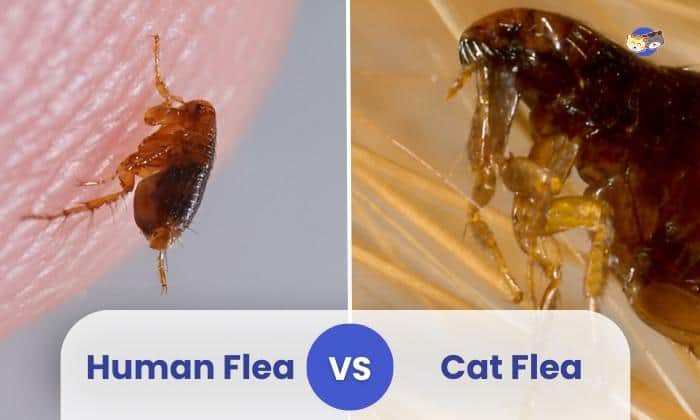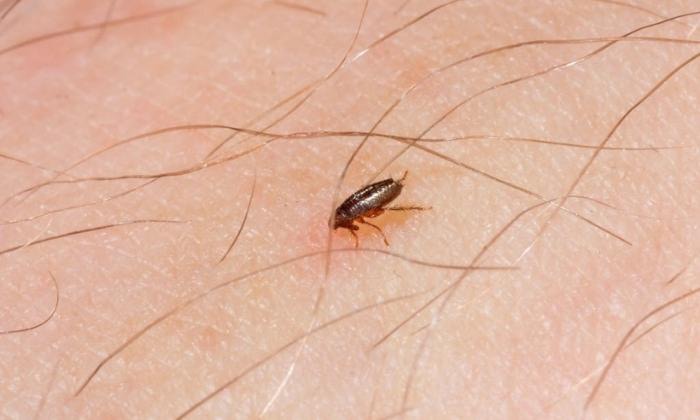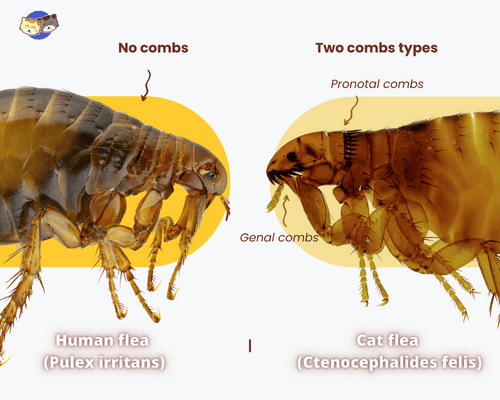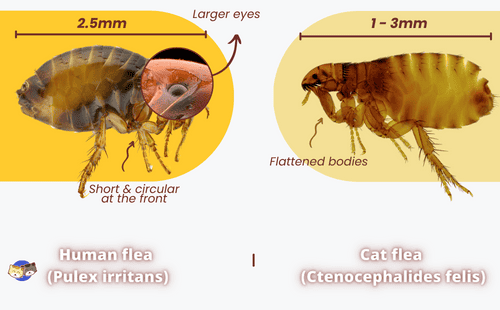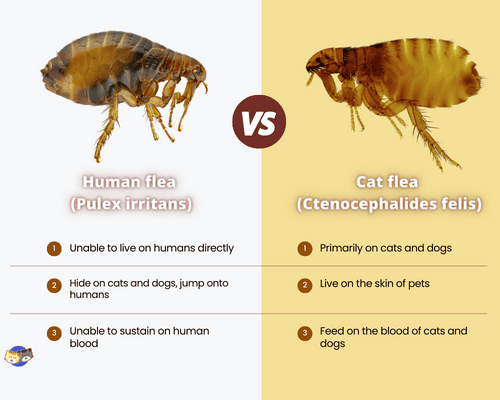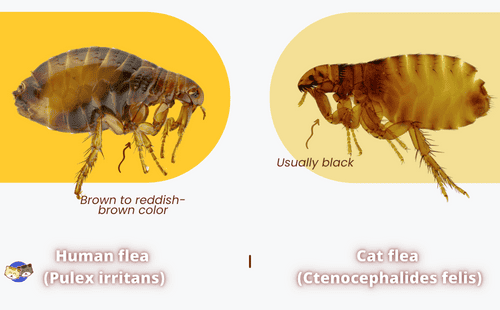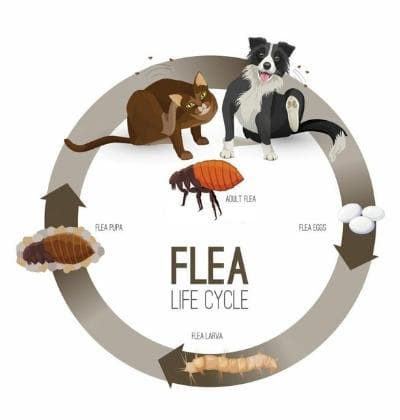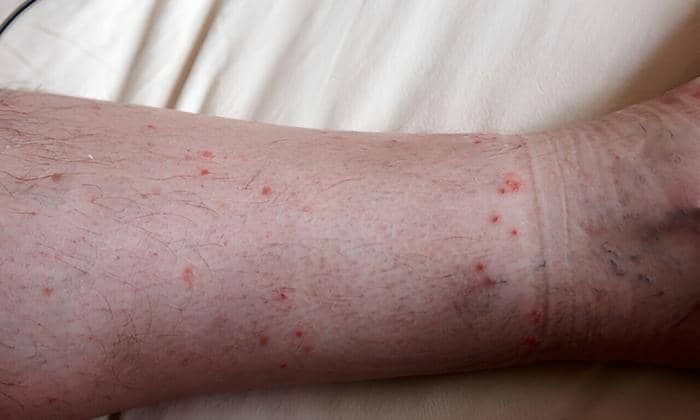Fleas are notorious pests that live on your pet’s skin, hiding in their furs. If you have a cat, I’m sure you have already seen this blood-sucking insect at least once.
But did you know that humans can get fleas, too? You might be wondering how they can survive in your bodies, considering we don’t have fur where they can hide.
This article will discuss everything you need to know about human flea vs cat flea. We’ll also tackle how you can prevent these parasites from pestering you and your furry friend.
| Human Fleas | Cat Fleas |
| Do not have combs or spines running from their heads to their backs | Have genal and pronotal combs |
| Measures 2.5 mm once they reach adulthood | Measures 1 to 3 mm |
| Also lives on cats and dogs, as they can’t survive on human hosts | Primarily lives on cats and dogs |
| Lives in poorly kept, unsanitary areas | Common in areas with pets |
| Brown to reddish-brown in color | Black in color |
Table of Contents
What Are Cat Fleas?
Cat fleas are small, wingless parasites that feed off the blood of felines. They are the most common type of domestic fleas that can be found not only on cats but also on other warm-blooded hosts like foxes, dogs, and opossums.
Adult cat fleas primarily live on their host feline. However, its eggs, larvae, and pupae live in your cat’s surrounding environment.
The reason is that only adult cat fleas can hold onto your pet’s skin using the strong claws on their legs. Meanwhile, unhatched fleas only lay on felines’ skin and fur, so they easily fall when the animal moves.
You will commonly find flea eggs, larvae, and pupae on beddings, furniture, and carpets or floors.
What Are Human Fleas?
Human fleas are among the approximately 2,000 species of fleas. They are wingless parasites that survive by feeding on their host’s blood. It is believed that these pests originated from South Africa, although no significant studies back this claim.
Contrary to their name, human fleas don’t usually feed on human blood. Instead, they infest warm-blooded mammals, just like how cat fleas do.
The saliva of human fleas has an enzyme that triggers an allergic reaction in humans. This results in itchy rashes that are usually harmless, though infections can occur.
Human fleas can also be bearers of flea-borne diseases like tapeworm, murine typhus, and tularemia.
Fortunately, the chances of human flea bites causing these diseases are relatively rare.
Cat Flea vs Human Flea: The Differences
While cat and human fleas are similar in appearance, they also have some notable differences:
1. The Presence of Combs
Cat fleas have spines along its body and legs called combs. These combs are divided into two types – the genal and pronotal comb.
On the other hand, human fleas do not have combs.
2. Size Comparison
Adult cat fleas measure around 1 to 3 millimeters. They are typically black or reddish-brown in color with bodies a bit flattened at the top.
Human flea size only measures 2.5 millimeters once they reach adulthood. Their bodies are short and circular at the front, unlike the flattened bodies of the common pet fleas.
Human fleas also have larger eyes.
3. Host
Cat fleas primarily live on the skin of cats and dogs. If you have a pet at home, cat fleas may also bite and feed on your blood.
It is worth noting that while human fleas have such a name, they cannot live on humans, and this applies to other flea types as well. The reason is that we lack the hair that these pests need to hide and protect themselves, and we tend to wash ourselves or shower daily.
So where do human fleas come from? They hide on cats and dogs, as they are the usual human companions. These parasites will jump onto us and stay inside our clothes until they can find a host animal to thrive on.
4. Habitat
If you’re wondering where fleas come from and where they live, cat fleas are common in homes with pets, especially cats and dogs.
In fact, it is recorded that they are the culprit in 75 percent of home infestations, and they have a great ability to sense carbon dioxide and warmth, two things that indicate suitable hosts.
On the other hand, human fleas are commonly found in unsanitary areas. They are abundant in flop houses, slums, sawmill towns, and farms with abandoned pig pens.
Fortunately, human fleas are relatively rare in many parts of the world.
5. Color
Adult cat fleas are usually black, while human fleas are brown to reddish-brown in color.
Life Cycle of Human and Cat Fleas
Like many species of fleas, human and cat fleas have the same four stages in their life cycle:
- The adult female flea lays eggs after feeding on the blood of its host.
- The eggs will hatch and turn into worm-like larvae. These larvae feed on organic debris and blood for several days to weeks until they reach the next stage.
- After the larvae have matured, they form a cocoon as their protective barrier. This cocoon can stay in place for months or years, until a suitable host is detected.
- After developing inside the pupa, the adult flea will emerge into the environment and feed on its host.
Flea Health Risks and Concerns
Flea mouths and saliva often carry bacteria and organisms that can cause various diseases to their host animals and people. Some of these diseases can even be fatal.
People and animals can also be allergic to flea saliva. So, when a flea bites them, they experience reactions like redness and itching.
In severe cases, those allergic to fleas can develop hives and infections. It’s worth noting that you can experience an allergic reaction whether the bite comes from brown fleas vs black fleas.
How to Control and Prevent Fleas
Here are some of the things you can do to control and prevent flea infestation in your pets and home:
- Treat Your Pets. If you suspect your pet has fleas, take it to a vet so they can prescribe flea-killing products like topical treatments, oral medications, and grooming regimes.
- Groom Your Pet Regularly. Brush your pet regularly, especially if they have long fur. This helps remove adult fleas and their eggs.
- Wash Your Pet’s Bedding. Washing the items used by your pets in hot detergent water can kill fleas and their eggs.
- Vacuum Regularly. When vacuuming your home, pay attention to the areas where your pet spends a lot of time. Fleas can hide in carpets, furniture, and rugs, so make sure you vacuum them well.
Conclusion
Though there are differences between human flea vs cat flea, both can lead to a poor quality of life for you and your pet. Even worse, they can cause allergies and even diseases in more serious cases.
For this reason, cleaning your home to remove and prevent fleas from coming back is crucial. If vacuuming alone does not work, you can steam clean your carpets to kill the fleas and eggs hiding there.

I pursued veterinary studies at the University of Kansas. After several years of practice, I established a veterinary clinic in Kansas. When Michael extended an invitation with a vision that went beyond emergency support – sharing of caregiving information for guardians to create the best living environment for cats, I didn’t hesitate to join the organization.
My role here involves verifying the information presented on the official website. With my experience, I believe the information provided is entirely accurate. If you have any concerns, please feel free to reach out to me


